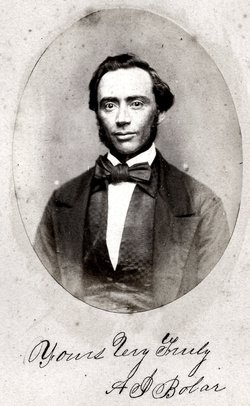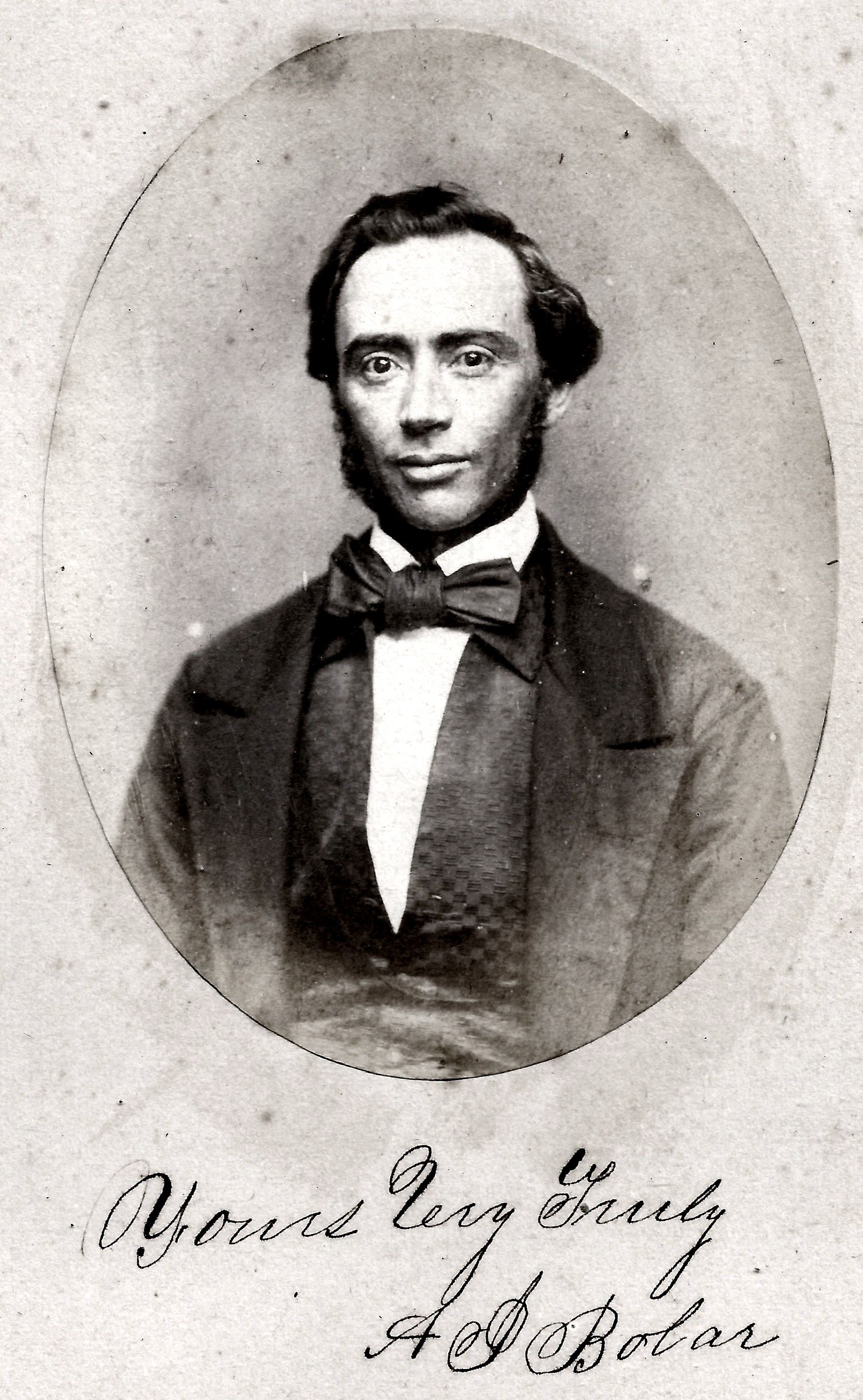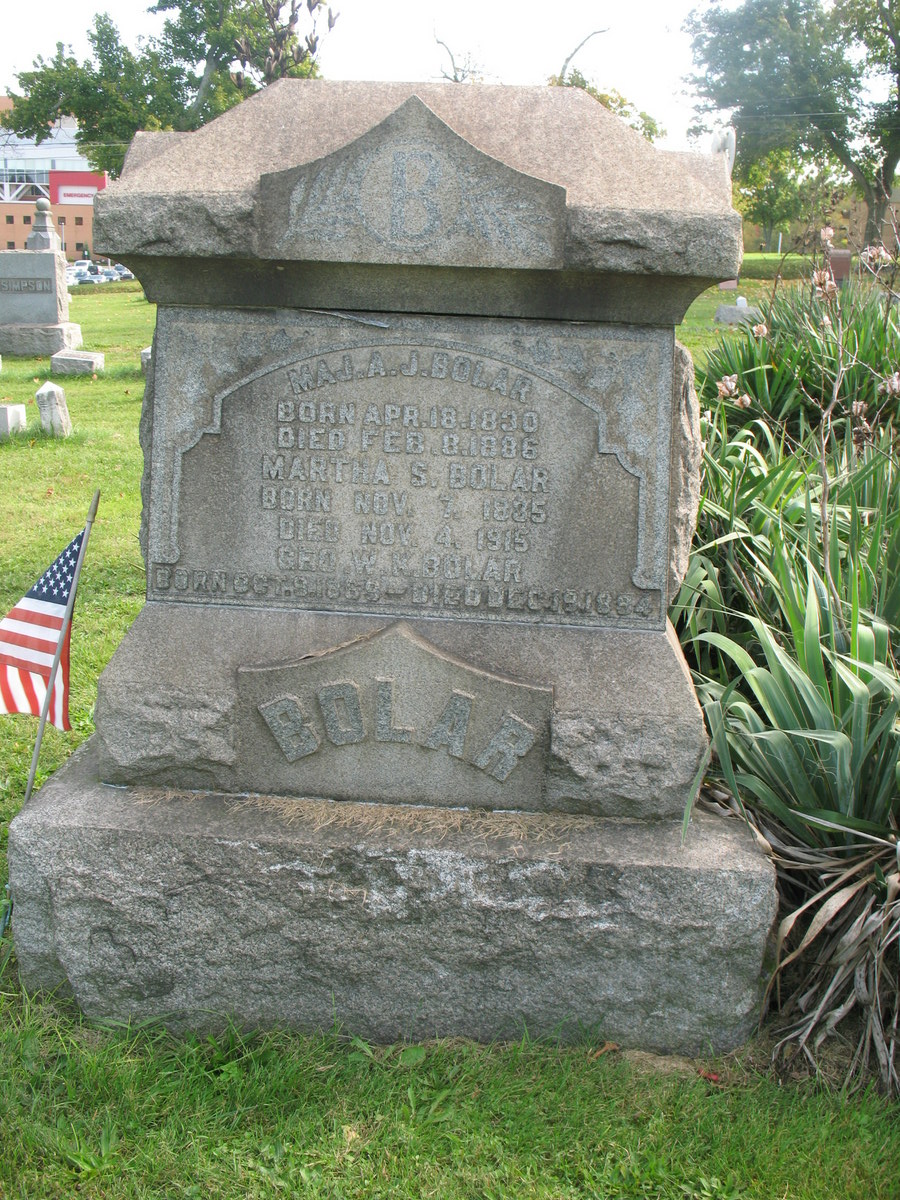Major A.J. Bolar, a brave and gallant soldier during the Civil War, died from the effects of his wounds at his home in Homer City during the month of February. Maj. Bolar entered the ministry in 1860, served as a soldier during the war, was elected superintendent of Indiana county in 1866, and served one term, was teacher of mathematics in the Normal school at Indiana, Pa., resigned this to accept the principalship of the Blairsville Academy.
This last position he was compelled to give up and seek medical treatment which though the best man could give, was not sufficient to save his life. His remains were entered in Greenwood Cemetery at Indiana, Pa.
12th Reserves Company H - Major Bolar was wounded in both legs and captured at Fredericksburg on Dec 13, 1862, and sent to Libby Prison in Richmond.
Major Staff 41st Reg. 12th Res. Pennsylvania Volunteers
"Case 692. — Major A. J. Bolar, 12th Pennsylvania Reserves, aged 31 years, was wounded in both legs and captured at Fredericksburg, December 13, 1862. After remaining a prisoner some weeks he was exchanged and conveyed to Annapolis, where he was admitted to hospital on February 21, 1863. Acting Assistant Surgeon J. H. Longnecker reported: "This officer was wounded in the left leg by a round ball entering three inches below the knee joint and fracturing the fibula; also by a buckshot in the same locality and a minie ball entering the external upper third of the leg. There was compound fracture of both the tibia and fibula. The ball has never been found, and is supposed to have lodged in the muscular part of the leg. The right leg was also wounded by a minie ball entering at the outer tuberosity and passing under the patella. At the time of admission the wound of the right leg was open and discharging. On, September 9th, when the patient was put under my care, it had closed and there was anchylosis of the knee joint. The left leg was very much swollen and inflamed, there being two angry looking ulcers about three or four inches below the knee joint, with a tendency to sloughing. The patient's general health was good. Charcoal poultices were ordered, to be renewed twice a day. On September 21st, flaxseed was substituted for the charcoal, the wound looking more healthy and granulating, with not so much swelling or redness, and the pain less acute. On October 1st, two small fistulous openings remained, discharging a thin, sanious, and offensive ichor with small parts of decayed bone, which were injected with a mixture of opodeldoc and sweet oil twice a day. By November 1st, the discharge was much less and of a better quality, the leg of natural size, and the patient able to walk much easier with the aid of crutches. About December 1st, there was still slight discharge, the pus being mixed with small black particles, indicating exfoliation. Gradual improvement continued, and one month later the patient was able to walk by the support of a cane." He was honorably discharged from service January 30, 1864, and subsequently entered the Veteran Reserve Corps, being ultimately mustered out June 6, 1865, and pensioned. Examining Surgeon G. R. Lewis, of Indiana, Pennsylvania, certified, February 8, 1867: "The pensioner was wounded in the left leg by several balls, one being still unremoved. The wound is still discharging and requires to be dressed daily. He was also wounded in the right knee, the ball lodging. Complete anchylosis resulted." On September 21, 1875, the same Examiner reported: "The ball in the left leg has not been removed and the wound still discharges, etc. There is partial stiffness of the knee joint, and he is totally disabled for manual labor." Examiner M. L. Miller, of Blairsville, Pennsylvania, September 4, 1877, certified to the injuries and added: "There has been much muscular waste and tenderness of the parts (left leg), and there is discharge of offensive matter from the place of injury, requiring daily dressing." The pensioner was paid September 4, 1880." -- The Medical and Surgical History of the War of the Rebellion. Part III, Volume II. (3rd Surgical volume) by U.S. Army Surgeon General's Office.
Per Ed Poole, Major Bolar had 5 children:
Harry White Bolar 1867-1944
George W. Bolar 1870-1894
Andrew J. Bolar 1872-1945
Martha W Bolar Saunders 1874-1965
William Carl Bolar 1878-1914
Major A.J. Bolar, a brave and gallant soldier during the Civil War, died from the effects of his wounds at his home in Homer City during the month of February. Maj. Bolar entered the ministry in 1860, served as a soldier during the war, was elected superintendent of Indiana county in 1866, and served one term, was teacher of mathematics in the Normal school at Indiana, Pa., resigned this to accept the principalship of the Blairsville Academy.
This last position he was compelled to give up and seek medical treatment which though the best man could give, was not sufficient to save his life. His remains were entered in Greenwood Cemetery at Indiana, Pa.
12th Reserves Company H - Major Bolar was wounded in both legs and captured at Fredericksburg on Dec 13, 1862, and sent to Libby Prison in Richmond.
Major Staff 41st Reg. 12th Res. Pennsylvania Volunteers
"Case 692. — Major A. J. Bolar, 12th Pennsylvania Reserves, aged 31 years, was wounded in both legs and captured at Fredericksburg, December 13, 1862. After remaining a prisoner some weeks he was exchanged and conveyed to Annapolis, where he was admitted to hospital on February 21, 1863. Acting Assistant Surgeon J. H. Longnecker reported: "This officer was wounded in the left leg by a round ball entering three inches below the knee joint and fracturing the fibula; also by a buckshot in the same locality and a minie ball entering the external upper third of the leg. There was compound fracture of both the tibia and fibula. The ball has never been found, and is supposed to have lodged in the muscular part of the leg. The right leg was also wounded by a minie ball entering at the outer tuberosity and passing under the patella. At the time of admission the wound of the right leg was open and discharging. On, September 9th, when the patient was put under my care, it had closed and there was anchylosis of the knee joint. The left leg was very much swollen and inflamed, there being two angry looking ulcers about three or four inches below the knee joint, with a tendency to sloughing. The patient's general health was good. Charcoal poultices were ordered, to be renewed twice a day. On September 21st, flaxseed was substituted for the charcoal, the wound looking more healthy and granulating, with not so much swelling or redness, and the pain less acute. On October 1st, two small fistulous openings remained, discharging a thin, sanious, and offensive ichor with small parts of decayed bone, which were injected with a mixture of opodeldoc and sweet oil twice a day. By November 1st, the discharge was much less and of a better quality, the leg of natural size, and the patient able to walk much easier with the aid of crutches. About December 1st, there was still slight discharge, the pus being mixed with small black particles, indicating exfoliation. Gradual improvement continued, and one month later the patient was able to walk by the support of a cane." He was honorably discharged from service January 30, 1864, and subsequently entered the Veteran Reserve Corps, being ultimately mustered out June 6, 1865, and pensioned. Examining Surgeon G. R. Lewis, of Indiana, Pennsylvania, certified, February 8, 1867: "The pensioner was wounded in the left leg by several balls, one being still unremoved. The wound is still discharging and requires to be dressed daily. He was also wounded in the right knee, the ball lodging. Complete anchylosis resulted." On September 21, 1875, the same Examiner reported: "The ball in the left leg has not been removed and the wound still discharges, etc. There is partial stiffness of the knee joint, and he is totally disabled for manual labor." Examiner M. L. Miller, of Blairsville, Pennsylvania, September 4, 1877, certified to the injuries and added: "There has been much muscular waste and tenderness of the parts (left leg), and there is discharge of offensive matter from the place of injury, requiring daily dressing." The pensioner was paid September 4, 1880." -- The Medical and Surgical History of the War of the Rebellion. Part III, Volume II. (3rd Surgical volume) by U.S. Army Surgeon General's Office.
Per Ed Poole, Major Bolar had 5 children:
Harry White Bolar 1867-1944
George W. Bolar 1870-1894
Andrew J. Bolar 1872-1945
Martha W Bolar Saunders 1874-1965
William Carl Bolar 1878-1914
Family Members
-
![]()
Gilson Bolar
1832–1903
-
![]()
Mary Catherine Bolar Trindle
1835–1933
-
![]()
George R. Bolar
1837–1870
-
![]()
Elizabeth Ellen Bolar Ling
1839–1915
-
![]()
Malinda "Linnie" Bolar Cramer
1841–1911
-
![]()
Matilda Bolar Cramer
1843–1866
-
![]()
John A. Bolar
1844–1922
-
![]()
Cordelia "Dillie" Bolar Hess
1847–1882
-
![]()
Findley McCoy Bolar
1851–1945
-
![]()
Sarah F. Bolar
1855–1867
-
![]()
Lucinda Bouler
unknown–1851
Advertisement
Advertisement



























